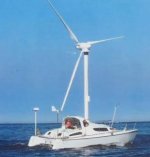TylerDurden
100 GW
Discussion continues here:
http://endless-sphere.com/forums/viewtopic.php?f=3&t=47528
http://endless-sphere.com/forums/viewtopic.php?f=3&t=47528
busted_bike said:I haven't read the whole thread, but I think I get it - maybe - so I'll try my own twist on an explanation. Forgive me if someone has already taken the same tact on an explanation.
First, it seems obvious that a tailwind turning a prop geared to the wheels would make the thing move forward, at least to the point of zero apparent wind. The question I kept coming back to and the thing that puzzled me was: why doesn't the prop start turning in the opposite direction once zero apparent wind speed is exceeded?
John in CR said:Traveling with the wind the spinning prop is blowing air against the wind. The entire prop system is like a sail running downwind, but the wind is blowing against a cushion of air coming off the prop instead of a sail.
Wind pushes against that system causing the wheels to turn the prop faster and capture more of the wind energy of the swept area of the prop, maybe even more than the swept area of the prop if the cushion of air it blows becomes larger than its swept area.
Errr? .. I think the WHEELS are pretty important to make this work ! :wink:fechter said:. I think it would be great for a boat though.
Hillhater said:Errr? .. I think the WHEELS are pretty important to make this work ! :wink:fechter said:. I think it would be great for a boat though.

itchynackers said:It's not that hard. A balloon is powered by the wind, and can only be as fast as the wind. A wind vehicle in contact with the ground is powered by the wind AND the ground, and can move faster than the wind.
busted_bike said:itchynackers said:It's not that hard. A balloon is powered by the wind, and can only be as fast as the wind. A wind vehicle in contact with the ground is powered by the wind AND the ground, and can move faster than the wind.
And yet a vehicle powered only by the ground goes nowhere... :wink:
Perhaps you're oversimplifying?
itchynackers said:It's not that hard. A balloon is powered by the wind, and can only be as fast as the wind. A wind vehicle in contact with the ground is powered by the wind AND the ground, and can move faster than the wind.
itchynackers said:It's not that hard. A balloon is powered by the wind, and can only be as fast as the wind. A wind vehicle in contact with the ground is powered by the wind AND the ground, and can move faster than the wind.
itchynackers said:It's not that hard. A balloon is powered by the wind, and can only be as fast as the wind. A wind vehicle in contact with the ground is powered by the wind AND the ground, and can move faster than the wind.
It depends in which frame of reference.busted_bike said:And yet a vehicle powered only by the ground goes nowhere..
